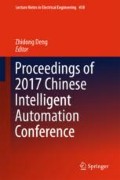Abstract
The wireless sensor network is applied widely in many fields to monitor the service condition of the devices. However, due to the limit energy of the sensor nodes, the lifetime of the wireless sensor network becomes the vital factor to guarantee the stability and reliability of the system. In this paper, the cluster-based method is adopted to minimize the energy consumption of all the nodes and balance the energy consumption among all sensors to prolong the lifetime of the sensor network to the extreme. First, we calculate the optimal number of the clusters, ensuring the minimizing of the total energy consumption; and then we optimal the clusters based on K-means ++, guaranteeing the nodes close to each other are divided into the same cluster and decrease the energy consumption among the Non-Cluster Head nodes and Cluster-Head node. The valid of the strategy is verified in the following simulation, and the lifetime of the sensor network is increased noticeably.
Access this chapter
Tax calculation will be finalised at checkout
Purchases are for personal use only
References
Wei D, Jin Y, Vural S, Moessner K, Tafazolli R (2011) An energy—efficient clustering solution for wireless sensor networks. IEEE Trans Wireless Commun 10(11):3973–3983
Zhang DG, Wang X, Song XD, Zhang T, Zhu Y-N (2015) A new clustering routing method based on PECE for WSN. EURASIP J Wirel Commun Networking 2015(1):1–13
Heinzelman WR, Chandrakasan A, Balakrishnan H (2000) Energy-efficient communication protocol for wireless micro-sensor networks, in System sciences. In: Proceedings of the 33rd annual Hawaii international conference on, IEEE, 2000, pp 1–10
Heinzelman WB, Chandrakasan AP, Balakrishnan H (2002) An application-specific protocol architecture for wireless micro-sensor networks. IEEE Trans Wireless Commun 1(4):660–670
Khan F (2012) An initial seed selection algorithm for k-means clustering of georeferenced data to improve replicability of cluster assignments for mapping application. Appl Soft Comput 12(11):3698–3700
Bholowalia P, Kumar A (2014) Ebk-means: a clustering technique based on elbow method and k-means in wsn. Int J Comput Appl 105(9)
Zimichev EA, Kazanskii NL, Serafimovich PG (2014) Spectral-spatial classification with k-means ++ particional clustering. Computer Optics 38(2):281–286
Liu F, Peng S (2010) On stabilization for stochastic control systems which the coefficient is time-variant. J Syst Sci Complex 23(2):270–278
Younis O, Fahmy S (2004) Heed: a hybrid, energy-efficient, distributed clustering approach for ad hoc sensor networks. IEEE Trans Mob Comput 3(4):366–379
Zhang H, Shen H (2009) Balancing energy consumption to maximize network lifetime in data-gathering sensor networks. IEEE Trans Parallel Distrib Syst 20(10):1526–1539
Acknowledgements
This work was supported by the National Science and Technology Major Project Grant No. 2016YFB1200100; State Key Laboratory under Grant No. RCS2016ZT018.
Author information
Authors and Affiliations
Corresponding author
Editor information
Editors and Affiliations
Rights and permissions
Copyright information
© 2018 Springer Nature Singapore Pte Ltd.
About this paper
Cite this paper
Ma, X., Dong, H., Jia, L., Zhao, R. (2018). Lifetime Maximization Strategy for Wireless Sensor Network Using Cluster-Based Method. In: Deng, Z. (eds) Proceedings of 2017 Chinese Intelligent Automation Conference. CIAC 2017. Lecture Notes in Electrical Engineering, vol 458. Springer, Singapore. https://doi.org/10.1007/978-981-10-6445-6_43
Download citation
DOI: https://doi.org/10.1007/978-981-10-6445-6_43
Published:
Publisher Name: Springer, Singapore
Print ISBN: 978-981-10-6444-9
Online ISBN: 978-981-10-6445-6
eBook Packages: EngineeringEngineering (R0)

